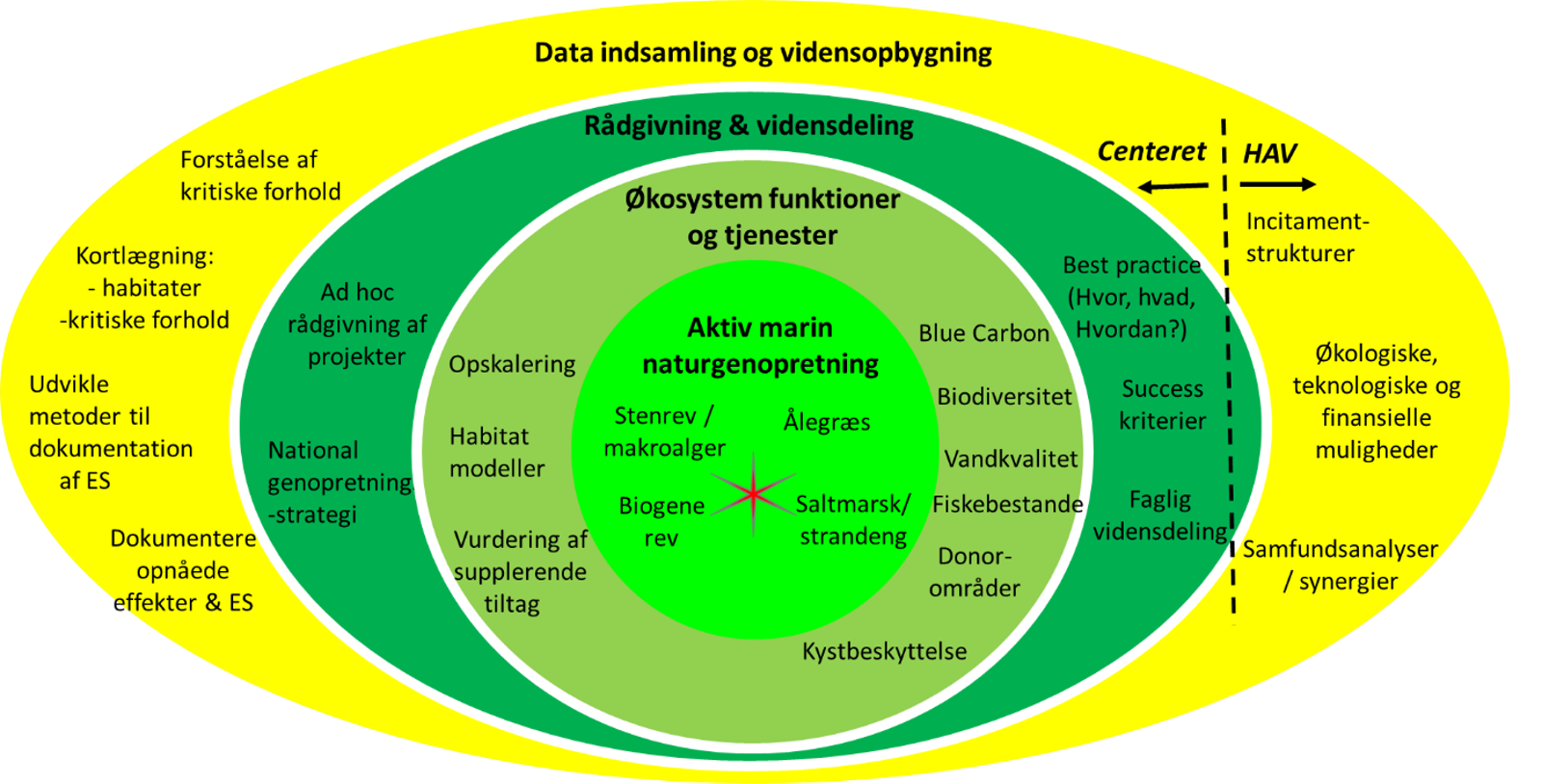About the Center for Marine Restoration
The Center for Marine Restoration aims to promote a knowledge-based approach to marine restoration. This is done in order to strengthen the resilience and ecological balance of marine ecosystems as well as a large number of ecosystem services in Danish waters.
The Center seeks to promote specialist knowledge and advice about various ecological, technical, and economic factors that lead the projects towards success and minimize failure.
As a contribution to the national effort on marine nature restoration and natural solutions that contribute to the improvement of the seas and fiords, the center wants to provide scientifically and professionally supported advice.
The Challenge
Denmark’s greatest contribution to the planet’s biodiversity is its low-water, coastal ecosystems. Despite centuries of hard work to improve water quality and the coastal marine environment, the ecological status of these ecosystems remains unsatisfactory. Even the protected natural habitats hold an unfavourable conservation status.
We recognise that it is no longer enough to reduce nutrient admissions to improve nature and environmental conditions. In many cases, active restoration is a necessary supplement when recreating the lost habitats and securing the valuable ecosystem services the sea provides, which, in turn, contributes to robust marine habitats (Orth et al. 2020).
In later years, a growing interest in active marine restoration has occurred. This interest stems from whishes for more fish near coastal zones and more natural variation along the coast. However, the completed projects have only to a limited amount contributed with knowledge on the projects' natural and environmental effects. Therefore, there is a great need for a knowledge-based approach to provide a better understanding of factors (ecological, technical, and economic) which will lead to success in future projects.
The Center’s Objectives
The Center for Marine Restoration wants to ensure that marine restoration projects in Denmark are completed on a scientific basis – this will also ensure optimal investments.
The Center is responsible for collecting, processing, and analysing data with the purpose of providing local actors, municipalities, and national players with knowledge on how to successfully complete various types of marine restoration projects. By sharing this knowledge, the Center optimizes the amount of ecosystem services that are made possible through marine restoration. Through marine restoration, the Center contributes to:
- Improved environmental conditions and state of nature
- Greater biodiversity
- Carbon storage
- Immobilizing nutrients
- Fishery and natural coastal protection in Danish waters
The Center provides support and makes sure that the outcome of each project is maximized.
Holistic Thinking

Consulting
The Center aims to provide effective consulting based on the collected data about successful marine restoration and the effects of said restoration (WP2), while also assessing ecosystem functions and services (WP3). Local and national authorities, interest groups, and scientists are among the main recipients of our consulting services. This is how we ensure the greatest level of success in our marine restoration projects, which promote the synergy between different natural, environmental, and climate actions.
Specific Tasks

Work Package 1 (WP1) – Center Management
Managing the Center encompasses planning projects and evaluating on these projects, which includes prioritizing between tasks. Furthermore, management must also administer the Center’s economy, resources, and fundraising with a focus on supporting new requirements (such as filling out knowledge gaps). These new requirements have also been identified by management. WP1 also handles all communication with The National Agency of Environmental Protection and other investors.
Work Package (WP2) – Knowledge Acquisition
Knowledge acquisition is a central task and encompasses:
Documentation of critical conditions (light, salinity, water quality, geology, currents) needs to be completed in order to successfully establish various types of marine habitats. What type of stone is optimal? How much water exchange is necessary? What are the correct levels of oxygen, temperature, nutrient concentrations, and salinity conditions? When does nutrient loading hinder natural reestablishment and restoration of various marine habitats?
This knowledge is collected through thorough reviews of environmental conditions surrounding existing restoration projects. The result would be a quantitative assessment of the criteria and tolerance levels which must be observed in a selection of areas suitable for marine restoration. From these criteria, a map is developed which makes it possible to point out areas that are well-suited for various types of restoration (screening). These maps are usually supported by further preliminary investigations before restoration starts.
Work Package 3 (WP3) – Sharing Knowledge and Consulting
Another central task is to provide knowledge concerning nature restoration, criteria which measure the success of nature restorations, and knowledge of the effects of these restorations, while also evaluating ecosystem functions and services (WP2). When sharing knowledge, we have a special focus on helping national (The National Agency of Environmental Protection) and local authorities, but also interest organizations and research scientists. The purpose is to ensure optimal implementation of marine restoration projects which are designed to create synergies between various natural, environmental and climate actions.
